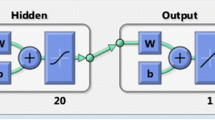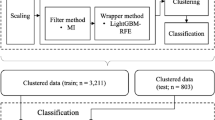Abstract
The aim of this study is to assess the ability of radial basis function (RBF) classifiers as an assistant tool for the diagnosis of the obstructive sleep apnoea syndrome (OSAS). A total of 187 subjects suspected of suffering from OSAS were available for our research. The initial population was divided into training, validation and test sets for deriving and testing our neural classifiers. We used nonlinear features from nocturnal oxygen saturation (SaO2) to perform patients’ classification. We evaluated three different RBF construction techniques based on the following algorithms: k-means (KM), fuzzy c-means (FCM) and orthogonal least squares (OLS). A diagnostic accuracy of 86.1, 84.7 and 85.5% was provided by the networks developed with KM, FCM and OLS, respectively. The three proposed networks achieved an area under the receiver operating characteristic (ROC) curve over 0.90. Our results showed that a useful non-invasive method could be applied to diagnose OSAS from nonlinear features of SaO2 with RBF classifiers.



Similar content being viewed by others
References
Aboy M, Hornero R, Abásolo D et al (2006) Interpretation of the Lempel-Ziv complexity measure in the context of biomedical signal analysis. IEEE Trans Biomed Eng 53:2282–2288
Álvarez D, Hornero R, Abásolo D et al (2006) Nonlinear characteristics of blood oxygen saturation from nocturnal oximetry for obstructive sleep apnoea detection. Physiol Meas 27:399–412
Basheer IA, Hajmeer M (2000) Artificial neural networks: fundamentals, computing, design, and application. J Microbiol Methods 43:3–31
Baxt WG (1995) Application of artificial neural networks to clinical medicine. Lancet 346:1135–1138
Bezdek JC (1981) Pattern recognition with fuzzy objective function algorithms. Plenum Press, New York
Bishop CM (1995) Neural networks for pattern recognition. Oxford University Press, Oxford
Bjorck A (1967) Solving linear least squares problems by Gram–Schmidt orthogonalization. BIT 7:1–21
Bloch KE (2003) Getting the most out of nocturnal pulse oximetry. Chest 124:1628–1630
Burioka N, Cornélissen G, Halberg F et al (2003) Approximate entropy of human respiratory movement during eye-closed waking and different sleep stages. Chest 123:80–86
Caldirola D, Bellodi L, Caumo A et al (2004) Approximate entropy of respiratory patterns in panic disorder. Am J Psychiatr 161:79–87
Catelani M, Fort A (2000) Fault diagnosis of electronic analog circuits using a radial basis function network classifier. Measurement 28:147–158
Chen S, Cowan CFN, Grant PM (1991) Orthogonal least squares learning algorithm for radial basis function networks. IEEE Trans Neural Netw 2:302–309
Cohen ME, Hudson DL, Deedwania PC (1996) Applying continuous chaotic modeling to cardiac signals. IEEE Eng Med Biol Mag 15:97–102
Cohen ME, Hudson DL (2000) New chaotic methods for biomedical signal analysis. In: Proceedings of the IEEE EMBS international conference on information technology applications in biomedicine, pp 123–128
El-Solh AA, Mador MJ, Ten-Brock E et al (1999) Validity of neural network in sleep apnea. Sleep 22:105–111
Er MJ, Chen W, Wu S (2005) High-speed face recognition based on discrete cosine transform and RBF neural networks. IEEE Trans Neural Netw 16:679–691
Folland R, Hines EL, Boilot P et al (2002) Classifying coronary dysfunction using neural networks through cardiovascular auscultation. Med Biol Eng Comput 40:339–343
Goldberger AL, Peng CK, Lipsitz LA (2002) What is physiologic complexity and how does it change with aging and disease? Neurobiol Aging 23:23–26
Hanley JA, McNeil BJ (1982) The meaning and use of the area under a receiving operating characteristic (ROC) curve. Radiology 143:29–36
Hanley JA, McNeil BJ (1983) A method of comparing the areas under receiver operating characteristic curves derived from the same case. Radiology 148:839–843
Haykin S (1999) Neural networks: a comprehensive foundation. Prentice-Hall, Englewood Cliffs
Hornero R, Abásolo D, Aboy M et al (2005) Interpretation of approximate entropy: analysis of intracranial pressure approximate entropy during acute intracranial hypertension. IEEE Trans Biomed Eng 52:1671–1680
Hornero R, Álvarez D, Abásolo D et al (2007) Utility of approximate entropy from overnight pulse oximetry data in the diagnosis of the obstructive sep apnea syndrome. IEEE Trans Biomed Eng 54:107–113
Hush DR, Horne BG (1993) Progress in supervised neural networks. IEEE Signal Process Mag 10:8–39
Jain AK, Murty MN, Flynn PJ (1999) Data clustering: a review. ACM Comput Surv 31:264–323
Jureyda S, Shucard DW (2004) Obstructive sleep apnea: an overview of the disorder and its consequences. Semin Orthod 10:63–72
Kirby SD, Danter W, George CFP et al (1999) Neural network prediction of obstructive sleep apnea from clinical criteria. Chest 116:409–415
Lempel A, Ziv J (1976) On the complexity of finite sequences. IEEE Trans Inf Theory 22:75–81
Leonard JA, Kramer MA (1991) Radial basis function networks for classifying process faults. IEEE Control Syst Mag 11:31–38
Magalang UJ, Dmochowski J, Veeramachaneni S et al (2003) Prediction of the apnea-hypopnea index from overnight pulse oximetry. Chest 124:1694–1701
Moller MF (1993) A scaled conjugate gradient algorithm for fast supervised learning. Neural Netw 6:525–533
Netzer N, Eliasson AH, Netzer C et al (2001) Overnight pulse oximetry for sleep-disordered-breathing in adults: a review. Chest 120:625–633
Pincus SM (2001) Assessing serial irregularity and its implications for health. Ann N Y Acad Sci 954:245–267
Rechtschaffen A, Kales A (1968) A manual of standardized terminology, techniques and scoring system for sleep stages of human subjects. Brain information services, Brain research institute, University of California, Los Angeles
Roche N, Herer B, Roig C et al (2002) Prospective testing of two models based on clinical and oximetric variables for prediction of obstructive sleep apnea. Chest 121:747–752
Schlosshan D, Elliot MW (2004) Sleep 3: clinical presentation and diagnosis of the obstructive sleep apnoea hypopnoea syndrome. Thorax 59:347–352
The Atlas Task Force (1992) EEG arousals: scoring rules and examples. A preliminary report from the Sleep Disorder Task Force of the American Sleep Disorders Association. Sleep 15:173–184
Van Houwelingen KG, Van Uffelen R, Van Vliet ACM (1999) The sleep apnoea syndromes. Eur Heart J 20:858–866
Vazquez JC, Tsai WH, Flemons WW et al (2000) Automated analysis of digital oximetry in the diagnosis of obstructive sleep apnoea. Thorax 55:302–307
Young T, Peppard PE, Gottlieb DJ (2002) Epidemiology of obstructive sleep apnea: a population health perspective. Am J Respir Crit Care Med 165:1217–1239
Zhang GP (2000) Neural networks for classification: a survey. IEEE Trans Syst Man Cybern Part C Appl Rev 30:451–462
Acknowledgments
This research has been supported by Consejería de Sanidad de la Junta de Castilla y León under project SAN/191/VA03/06. The authors are also thankful for the fruitful comments of the referees.
Author information
Authors and Affiliations
Corresponding author
Rights and permissions
About this article
Cite this article
Marcos, J.V., Hornero, R., Álvarez, D. et al. Radial basis function classifiers to help in the diagnosis of the obstructive sleep apnoea syndrome from nocturnal oximetry. Med Biol Eng Comput 46, 323–332 (2008). https://doi.org/10.1007/s11517-007-0280-0
Received:
Accepted:
Published:
Issue Date:
DOI: https://doi.org/10.1007/s11517-007-0280-0




